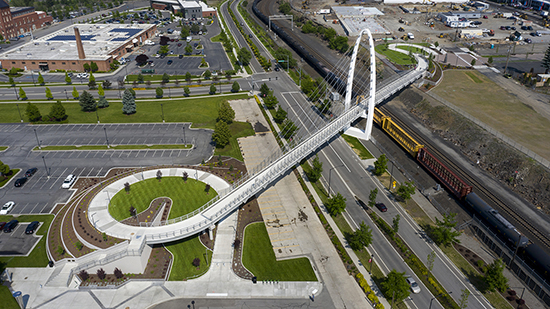|
Subscribe / Renew |
|
|
Contact Us |
|
| ► Subscribe to our Free Weekly Newsletter | |
| home | Welcome, sign in or click here to subscribe. | login |
Construction
| |
 |
February 5, 2021
National finalist: Gold award — Structural Systems
KPFF Consulting Engineers

Project: University District Gateway Bridge
Client: City of Spokane
When the city of Spokane began working on a university neighborhood master plan, the concept of constructing a pedestrian/bicycle bridge spanning the railroad tracks and connecting the East Sprague area to the University District emerged as a key catalyst in the master planning. This new connection now supports economic development for two vital and developing neighborhoods separated by railroad tracks and a busy arterial.
The bridge needed to create a welcoming sense of place while supporting future mixed-use development in the Sprague area and the medical district lying south of this corridor to the Riverpoint Campus academic facilities on the north where several universities have campuses.
KPFF’s final bridge design resulted from extensive stakeholder outreach and public involvement providing integral parts of the process. Outreach was broad and included elected officials, property owners, academic institutions, neighborhood groups, business owners and many special interest groups.
The height of the structure and the cable-stayed bridge’s aesthetics were intentionally chosen to stand out in the landscape to draw attention to the South University District area. Traditional railyard bridges inspired the robust details of the 450-foot span. Simultaneously, the 120-foot-tall concrete arch establishes the bridge as an icon and significant new landmark on Spokane’s skyline.
The selection of ramps for the approaches addressed challenging vertical grade requirements over railroad, roadway and transit corridors as high as 30 feet. This key decision also drove the structural solution from the shortest, perpendicular path across the rail and roadway corridors to a skewed bridge alternative. By skewing the bridge and adding length to the bridge spans themselves, part of the vertical height users would travel is taken up in the bridge deck’s slope. Reducing the height of the landings at both ends of the bridge, in turn, reduced the lengths of the approaches to make it more attractive to users.
Other Stories:
- National finalist: Platinum award — Structural Systems
Magnusson Klemencic Associates - National finalist: Gold award — Water Resources
Parsons and GeoEngineers - Best in State: Gold award — Future Value to the Engineering Profession
Century West Engineering - Inclusion Award — Midsize firm
- Engineer of the Year
- Best in State: Gold award — Complexity
Notkin, a P2S company - Inclusion Award — Midsize firm
- Best in State: Gold award — Social, Economic and Sustainable Design
Parametrix - National finalist: Gold award — Transportation
HDR - Best in State: Gold award — Unique or Innovative Applications
Parr Excellence - Best in State: Gold award — Successful Fulfillment of Client/Owner Needs
COWI North America and HNTB - National finalist: Gold award — Special Projects
HDR


